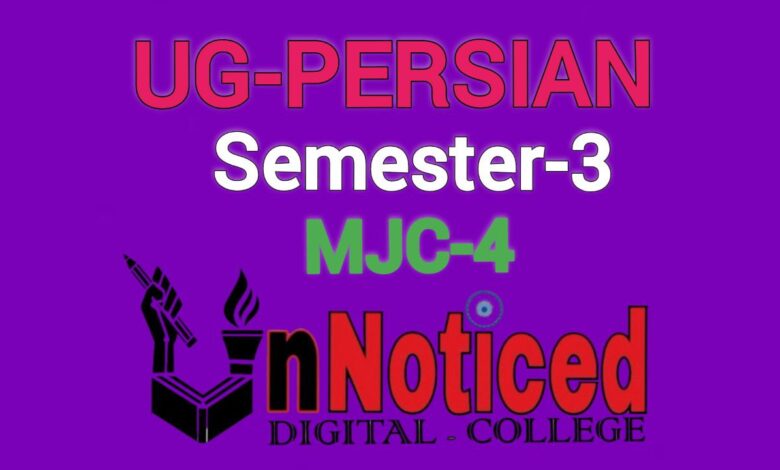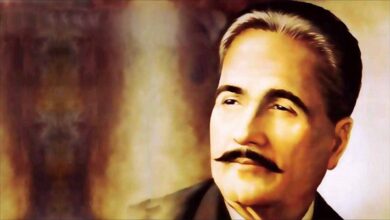
UG-PERSIAN, Semester-3, MJC-4, Ques-3 VVIP
غزل حافظ: “صبا به لطف بگو آن غزال رعنا را“
حافظ شیرازی کی غزل “صبا به لطف بگو آن غزال رعنا را” ان کی شاعری کی ایک حسین اور دلکش مثال ہے۔ یہ غزل حافظ کی عرفانی اور عاشقانہ شاعری کی نمائندگی کرتی ہے، جہاں شاعر نے محبوب کی دلکشی، حسن اور اس کی جاذبیت کا بیان کرتے ہوئے روحانی حقیقتوں کو بھی چھوا ہے۔ اس غزل میں جہاں ایک طرف شاعر کا دل محبوب کی طرف مائل نظر آتا ہے، وہیں دوسری طرف انسان کی داخلی کیفیت اور اس کی روحانی جستجو کو بھی پیش کیا گیا ہے۔ حافظ کی یہ غزل ان کی دیگر غزلوں کی طرح نہ صرف جمالیاتی اور جذباتی اثرات سے بھرپور ہے بلکہ اس میں ایک گہرا عرفانی اور فلسفیانہ پیغام بھی چھپا ہے۔
حافظ شیرازی کا تعارف
حافظ شیرازی، جنہیں عرف عام میں “حافظ” کے نام سے جانا جاتا ہے، 14ویں صدی کے عظیم فارسی شاعر تھے جو ایرانی ادب کے عظیم ستون سمجھے جاتے ہیں۔ ان کا پورا نام خواجہ شمس الدین محمد بن بہاء الدین حافظ تھا اور وہ شیراز میں پیدا ہوئے۔ حافظ کی شاعری نے نہ صرف ایرانی ادب پر گہرا اثر ڈالا بلکہ ان کی غزلیں پورے فارسی بولنے والے علاقے میں معروف ہوئیں اور آج بھی دنیا بھر میں پڑھی اور پسند کی جاتی ہیں۔
حافظ کی شاعری میں ایک منفرد امتزاج ہے؛ وہ محبت، حسن، جمال، عرفان، تصوف اور فلسفہ کو بڑے خوبصورت انداز میں پیش کرتے ہیں۔ ان کی غزلوں میں دل کی کیفیت، محبت کی شدت، اور انسان کے روحانی سفر کی گہرائیوں کو بیان کیا گیا ہے۔ حافظ کے کلام میں عشق کی حقیقت کو اور انسان کی خود شناسی کو بڑے بلیغ انداز میں پیش کیا گیا ہے، جس سے نہ صرف دنیاوی محبتوں کا اظہار ہوتا ہے بلکہ خدا کی محبت اور روحانی بیداری کا پیغام بھی ملتا ہے۔
غزل کا پس منظر
غزل “صبا به لطف بگو آن غزال رعنا را” میں حافظ نے اپنے محبوب کی دلکشی اور حسن کو انتہائی خوبصورتی سے بیان کیا ہے۔ اس میں صبا (ہوا) کے ذریعے محبوب کے بارے میں بات کی گئی ہے اور شاعر نے محبوب کے جمال کو اس قدر دلکش انداز میں پیش کیا ہے کہ وہ نہ صرف جسمانی حسن بلکہ ایک روحانی حسن کا بھی نمائندہ بن جاتا ہے۔ حافظ نے اس غزل میں اس محبوب کی خوبصورتی کی تعریف کی ہے جو شاعر کے دل میں ایک خاص مقام رکھتا ہے، اور وہ اپنی مسکراہٹ اور جاذبیت کے ذریعے شاعر کے دل کو تسخیر کرتا ہے۔
1. غزل کا پہلا شعر:
“صبا به لطف بگو آن غزال رعنا را“
اس شعر میں حافظ نے “صبا” (ہوا) کو ایک پیغام رسان کے طور پر استعمال کیا ہے جو محبوب تک شاعر کا پیغام پہنچاتی ہے۔ “صبا” عربی لفظ ہے جس کا مطلب ہے نرم ہوا، جو اکثر فارسی شاعری میں محبت، تسکین، اور ایک خوبصورت پیغام کے طور پر پیش کی جاتی ہے۔ حافظ یہاں صبا سے درخواست کر رہے ہیں کہ وہ محبوب تک یہ پیغام پہنچائے، “آن غزال رعنا” سے مراد ایک حسین اور جاذب شخصیت ہے۔ یہاں “غزال” کا لفظ محبوب کے حسن کی تشبیہ کے طور پر استعمال کیا گیا ہے، جو ایک نرم و نازک اور دلکش دل کی علامت ہے۔
غزال کا ذکر ایک مشہور اور خوبصورت استعارہ ہے جو فارسی شاعری میں محبوب کے جسمانی حسن کو بیان کرنے کے لیے استعمال ہوتا ہے۔ حافظ نے اس استعارے کو استعمال کر کے محبوب کے حسن کو بڑھا چڑھا کر بیان کیا ہے۔ شاعر کی خواہش ہے کہ صبا اس محبوب تک ان کی دل کی کیفیت اور جذبات پہنچائے۔
2. غزل کا دوسرا شعر:
“که من از دست او به فغان آمدم“
اس شعر میں حافظ ایک عاطفی کیفیت میں نظر آتے ہیں، جہاں وہ محبوب کے حسن کے اثرات سے پریشان ہیں۔ “فغان آمدم” سے مراد یہ ہے کہ شاعر محبوب کے حسن کی شدت سے بے چین ہیں اور ان کی حالت بے قابو ہو چکی ہے۔ حافظ یہاں اس بات کا اظہار کر رہے ہیں کہ محبوب کے جمال کے اثرات نے انہیں اس حد تک پریشان کیا کہ وہ بے اختیار ہو گئے ہیں اور ان کی روح میں ایک طوفان آ گیا ہے۔
یہاں حافظ نے “فغان” کا لفظ استعمال کیا ہے جو درد، اذیت اور بے چینی کی حالت کو ظاہر کرتا ہے۔ اس شعر میں ایک طرف شاعر کا دل محبوب کے جمال کی شدت میں ڈوب رہا ہے، تو دوسری طرف یہ اس بات کا بھی اشارہ ہے کہ انسان جب محبت کی شدت کو محسوس کرتا ہے، تو وہ داخلی طور پر ایک فکری و روحانی الجھن کا شکار ہو جاتا ہے۔
3. غزل کا تیسرا شعر:
“به سرم رفت و خود را از دست دادم“
یہ شعر حافظ کی داخلی کشمکش اور گمراہی کی عکاسی کرتا ہے۔ وہ کہتے ہیں کہ محبوب کے جمال کے سامنے ان کا دماغ غائب ہو چکا ہے اور وہ خود کو کھو بیٹھے ہیں۔ اس میں “خود را از دست دادم” سے مراد یہ ہے کہ شاعر اپنی عقل، ہوش و حواس کو محبوب کی محبت میں مکمل طور پر گم کر بیٹھے ہیں۔ حافظ یہاں اس بات کا بیان کر رہے ہیں کہ انسان جب محبت میں ڈوبتا ہے تو وہ اپنی حقیقت کو بھول کر صرف محبوب کی محبت میں محو ہو جاتا ہے۔
4. غزل کا چوتھا شعر:
“گفتم به تو که همچو تو باشم“
اس شعر میں حافظ اپنے دل کی خواہش کو بیان کرتے ہیں۔ وہ محبوب سے کہتے ہیں کہ وہ بھی اس کی طرح بننا چاہتے ہیں، اس کی طرح بے خود، بے اختیار، اور مکمل طور پر محبت میں ڈوبے ہوئے۔ یہاں “باشم” کا لفظ اس بات کو ظاہر کرتا ہے کہ حافظ اپنی ذات کو محبوب کے رنگ میں رنگنے کی آرزو رکھتے ہیں۔
5. حافظ کی شاعری کا فلسفہ
حافظ کی شاعری میں ایک خاص روحانیت اور فلسفہ پایا جاتا ہے۔ ان کی غزلوں میں صرف جسمانی حسن کی بات نہیں کی جاتی، بلکہ ایک گہری روحانی حقیقت کی طرف اشارہ کیا جاتا ہے۔ حافظ کے نزدیک محبوب کا جمال صرف ایک ظاہری حسن نہیں ہے، بلکہ اس کے اندر ایک روحانی حقیقت بھی چھپی ہوئی ہے، جو انسان کو خود شناسی اور خدا کی حقیقت تک پہنچنے کی رہنمائی دیتی ہے۔
حافظ کی شاعری میں ایک فلسفیانہ پہلو بھی ہے جہاں وہ انسان کی داخلی کیفیتوں اور جذباتی کشمکش کو بیان کرتے ہیں۔ ان کی غزلوں میں انسان کو اپنی حقیقت کو سمجھنے اور اپنے دل کی گہرائیوں میں جھانکنے کی دعوت دی جاتی ہے۔ ان کے ہاں عشق ایک روحانی سفر ہے جس کے ذریعے انسان اپنی اصل حقیقت کو دریافت کرتا ہے۔
6. نتیجہ
غزل “صبا به لطف بگو آن غزال رعنا را” میں حافظ نے محبوب کے جمال کو نہ صرف جسمانی حسن کے طور پر پیش کیا ہے بلکہ اس کے ذریعے ایک گہری روحانی حقیقت کی طرف بھی اشارہ کیا ہے۔ اس غزل کے ذریعے حافظ انسان کو اپنے دل کی گہرائیوں میں جھانکنے اور محبت کی حقیقت کو سمجھنے کی دعوت دیتے ہیں۔ حافظ کی یہ غزل نہ صرف ان کی شاعری کا ایک قیمتی حصہ ہے بلکہ ایک روحانی پیغام بھی دیتی ہے، جو آج بھی ہمارے دلوں کو چھو جاتا ہے۔
حافظ کی شاعری میں محبت اور عرفان کا حسین امتزاج ہے، جو اس غزل میں واضح طور پر نظر آتا ہے۔ یہ غزل نہ صرف محبوب کے جمال کی تعریف کرتی ہے بلکہ ایک گہری روحانی حقیقت کی طرف بھی اشارہ کرتی ہے، جس سے انسان کی حقیقت اور اس کے تعلقات کا پورا منظرنامہ سامنے آتا ہے۔
Hafez’s Ghazal: “Saba Be Lutf Bego Aan Ghazal-e-Ra’na Ra”
Hafez Shirazi’s ghazal “Saba Be Lutf Bego Aan Ghazal-e-Ra’na Ra” is a beautiful and captivating example of his poetry. This ghazal represents Hafez’s mystical and romantic poetry, where the poet describes the charm, beauty, and allure of the beloved while touching on spiritual truths as well. In this ghazal, on one hand, the poet’s heart appears drawn toward the beloved, while on the other hand, the inner state of the human soul and its spiritual quest are also portrayed. Like many of his other ghazals, Hafez’s poem is not only rich in aesthetic and emotional effects but also contains a deep mystical and philosophical message.
Introduction to Hafez Shirazi
Hafez Shirazi, commonly known as “Hafez,” was a great Persian poet of the 14th century, regarded as one of the pillars of Iranian literature. His full name was Khwaja Shamsuddin Muhammad bin Bahauddin Hafez, and he was born in Shiraz. Hafez’s poetry has had a profound impact on Iranian literature, and his ghazals became famous throughout the Persian-speaking world, continuing to be read and appreciated globally to this day.
Hafez’s poetry has a unique blend; he masterfully presents love, beauty, aesthetics, mysticism, Sufism, and philosophy. His ghazals express the state of the heart, the intensity of love, and the deep journey of the human soul. Hafez’s work eloquently portrays the truth of love and human self-awareness, reflecting not only worldly expressions of love but also messages about divine love and spiritual awakening.
Background of the Ghazal
In the ghazal “Saba Be Lutf Bego Aan Ghazal-e-Ra’na Ra,” Hafez describes the charm and beauty of his beloved with great elegance. The ghazal employs the metaphor of “Saba” (the wind) to convey messages about the beloved, and the poet presents the beauty of the beloved in such a way that it represents not just physical beauty, but also a spiritual one. In this ghazal, Hafez praises the beauty of the beloved who occupies a special place in the poet’s heart, capturing his heart with their smile and charm.
1. First Verse of the Ghazal: “Saba be lutf bego aan ghazal-e-ra’na ra” In this verse, Hafez uses “Saba” (the wind) as a messenger to deliver a message to the beloved. “Saba” is an Arabic word meaning gentle wind, often portrayed in Persian poetry as a symbol of love, comfort, and a beautiful message. Hafez is asking the wind to carry his message to the beloved, referring to them as “the graceful gazelle.” The word “gazelle” is a popular and beautiful metaphor used in Persian poetry to describe the beloved’s physical beauty, symbolizing a delicate, tender, and captivating heart.
The mention of “gazelle” is a famous and beautiful metaphor used in Persian poetry to describe the physical beauty of the beloved. Hafez uses this metaphor to enhance the description of the beloved’s beauty. The poet’s desire is that the wind conveys his emotions and feelings to the beloved.
2. Second Verse of the Ghazal: “Ke man az dast-e-oo be faghān āmdam” In this verse, Hafez expresses an emotional state where he is troubled by the effects of the beloved’s beauty. “Faghān āmdam” refers to the poet being overwhelmed and distressed by the intensity of the beloved’s beauty. Hafez is conveying that the overwhelming beauty of the beloved has disturbed him to such an extent that he is now helpless and his soul is in turmoil.
Here, Hafez uses the word “faghān” to represent pain, agony, and restlessness. On one hand, the poet’s heart is submerged in the intensity of the beloved’s beauty, and on the other hand, this also indicates that when a person experiences the intensity of love, they become internally conflicted and spiritually disoriented.
3. Third Verse of the Ghazal: “Be saram raft o khod ra az dast dādam” This verse reflects Hafez’s inner turmoil and confusion. He says that in the face of the beloved’s beauty, his mind has disappeared, and he has lost himself. The phrase “khod ra az dast dādam” implies that the poet has completely lost his mind, reason, and awareness in the beloved’s love. Hafez is describing that when a person falls deeply in love, they forget their own identity and become completely absorbed in the beloved’s love.
4. Fourth Verse of the Ghazal: “Goftam be to ke hamcho to basham” In this verse, Hafez expresses his deepest wish. He tells the beloved that he desires to become like them—lost, helpless, and completely immersed in love. The word “basham” reflects the poet’s wish to transform himself into the beloved’s likeness, to be absorbed in the beloved’s state of being.
5. Philosophy of Hafez’s Poetry
Hafez’s poetry contains a distinct sense of spirituality and philosophy. In his ghazals, he does not simply speak of physical beauty, but also hints at a deeper spiritual truth. For Hafez, the beauty of the beloved is not just outward appearance but also embodies a spiritual reality, guiding a person toward self-awareness and the truth of God.
Hafez’s poetry has a philosophical dimension, where he describes the inner states of human beings and their emotional struggles. His ghazals invite individuals to understand their true essence and look within their hearts. For Hafez, love is a spiritual journey through which a person discovers their true self.
6. Conclusion
In the ghazal “Saba Be Lutf Bego Aan Ghazal-e-Ra’na Ra,” Hafez presents the beloved’s beauty not only as a physical attribute but also as a symbol of a deeper spiritual truth. Through this ghazal, Hafez invites people to look within their hearts and understand the essence of love. This ghazal is not only a valuable part of Hafez’s poetry but also conveys a spiritual message that continues to touch our hearts today.
Hafez’s poetry beautifully combines love and mysticism, which is clearly evident in this ghazal. The poem not only praises the beauty of the beloved but also points to a deeper spiritual reality, revealing a complete view of human nature and its relationships.






